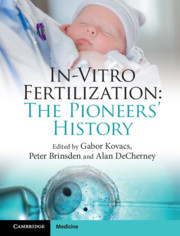Celebrating World Embryologist Day 2020
World Embryologist Day this year will be celebrated on Louise Brown’s 42nd birthday. To celebrate her 40th in 2018, Cambridge University Press published “In-Vitro Fertilization: The Pioneers’ History”, and the book was launched at Louise’s 40th birthday lunch at Bourn Hall. The book’s 30 chapters cover the history of development of IVF units in many countries around the world, many written by the people who were there, others by people who were closely associated with the pioneers.
Interestingly, the term “embryologist” was unknown 50 years ago. We suppose Bob Edwards was considered the first embryologist in the world, closely followed by Alex Lopata (who co-authored the Australian chapter in the pioneers’ book). Jean Purdy, although trained as a nurse, was trained by Bob Edwards as a laboratory research assistant to help him perform procedures in IVF, duties that now are performed by embryologists.
The next embryologist was Alan Trounson, who transferred his animal experience with sheep to humans and was the initial “hands on” scientist for the Monash team. There were many other scientists who contributed, and although not strictly embryologists, would be considered as reproductive biologist-embryologists who made significant contributions to developing the IVF culture systems. These included Wes Whitten from Australia, David Whittingham, Anne McLaren, John Biggers (author of chapter 1 in In-Vitro Fertilization: The Pioneers’ History), Barry Bavister in the UK, and Ralph Brinster in USA.
 Eventually, the preparation of sperm, the isolation of oocytes from follicular fluid and their preparation for insemination, observation of oocytes the day after insemination to confirm fertilisation, embryo handling and preparation for embryo transfer became the role of embryologists. These came from the fields of experimental embryologists, veterinary researchers and biology technicians, usually with ‘‘On The Job Training (OJT)”. The early embryologists included Simon Fishel, Colin Howles and then Jacques Cohen (author of chapter 2) at Bourn Hall, Lucinda Veeks (Norfolk USA) and Patrick Quinn (Australia). Other embryologists specialised in sperm biology such as David Mortimer (UK, Sydney and Canada), whilst others pioneered preimplantation genetic diagnosis/screening such as Alan Handyside and Marilyn Monk (UK), Santiago Munné with Jacques Cohen, Yuri Verlinsky (USA) and Leanda Wilton (Australia and UK).
Eventually, the preparation of sperm, the isolation of oocytes from follicular fluid and their preparation for insemination, observation of oocytes the day after insemination to confirm fertilisation, embryo handling and preparation for embryo transfer became the role of embryologists. These came from the fields of experimental embryologists, veterinary researchers and biology technicians, usually with ‘‘On The Job Training (OJT)”. The early embryologists included Simon Fishel, Colin Howles and then Jacques Cohen (author of chapter 2) at Bourn Hall, Lucinda Veeks (Norfolk USA) and Patrick Quinn (Australia). Other embryologists specialised in sperm biology such as David Mortimer (UK, Sydney and Canada), whilst others pioneered preimplantation genetic diagnosis/screening such as Alan Handyside and Marilyn Monk (UK), Santiago Munné with Jacques Cohen, Yuri Verlinsky (USA) and Leanda Wilton (Australia and UK).
Today becoming an embryologist is no longer through OJT. There are many training courses for budding embryologists. An early one that started was in Nottingham, UK, but one that has trained hundreds of embryologists working all over the world is at Monash University’s Educational Programme for Reproduction and Development which started in 1988. Prerequisites are an honours science degree, or a degree with some previous experience. However, the hands on part of training is still an apprentice system in most centres around the world.
There are also many professional organisations supporting embryologists, providing quality assurance and professional development. It is recognised that embryologists are the “engine house” of IVF units and they are essential for maintaining pregnancy rates. It is estimated that there are over 6,000 IVF units in the world, with the largest of these (in Tokyo) treating more than 35,000 couples each year. Therefore, there is and always will be a need for embryologists to allow these clinics to function.
In-Vitro Fertilization: The Pioneers’ History is a stimulating record chartering the history and pioneers of in-vitro fertilization, forty years after the birth of the first baby. The book is edited by Gabor Kovacs, Peter Brinsden and Alan DeCherney.
Get 20% off select IVF titles, including In-Vitro Fertilization: The Pioneers’ History, by clicking here.





